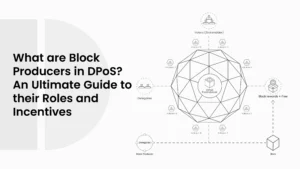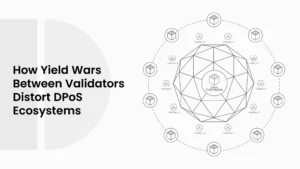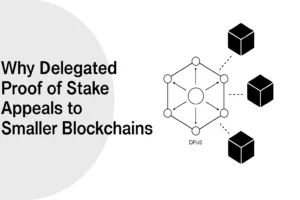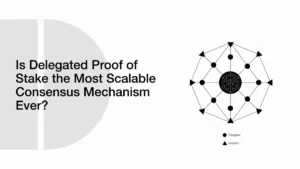How DPoS Remains the Backbone of Blockchain Governance in the Layer 2 Era
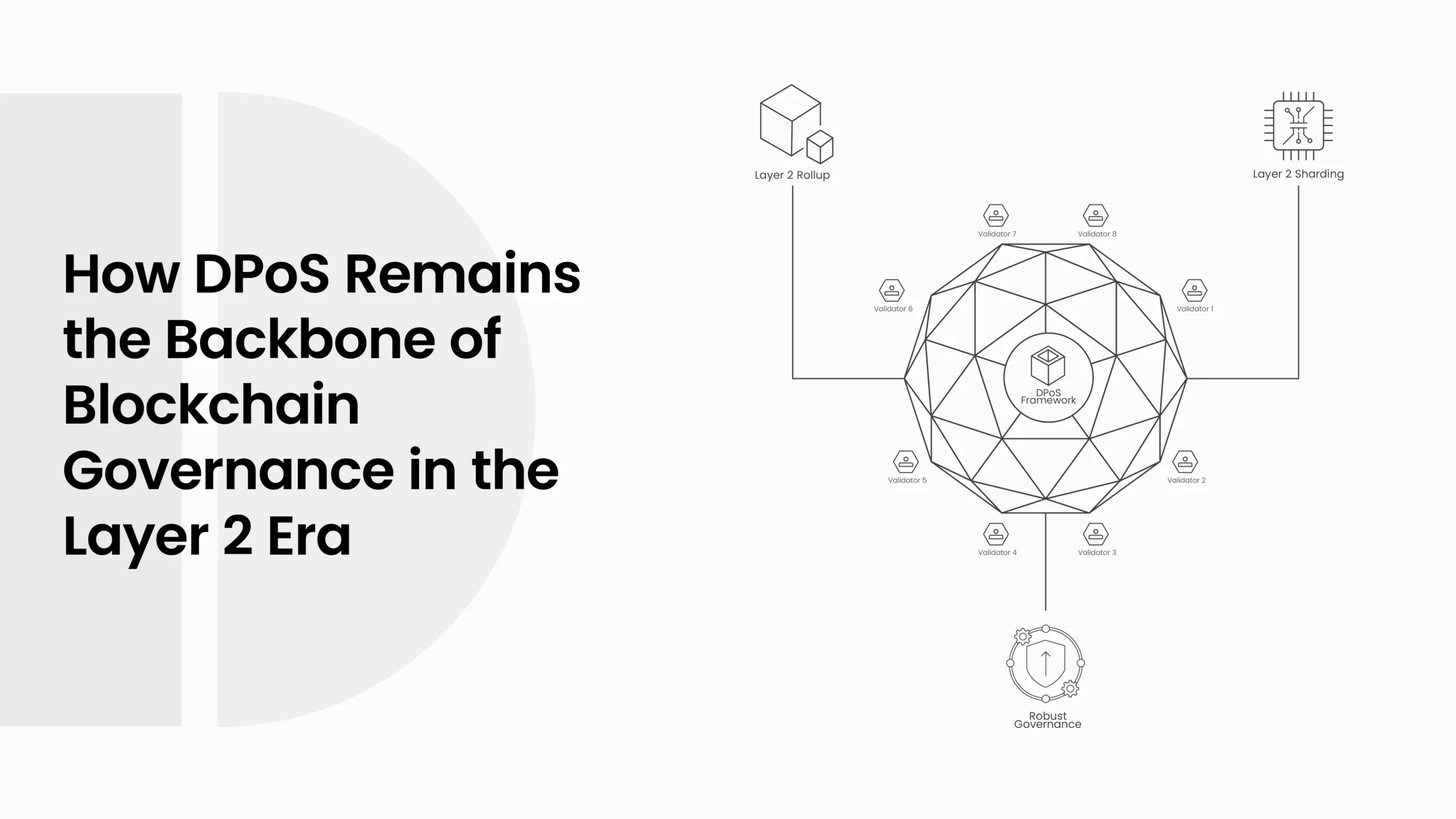
Over the past few years, blockchain has undergone significant changes. Everyone is now talking about Layer 2 networks because they enable faster and cheaper transactions. Still, when you look deep, you find something important holding the base of it all. That thing is Delegated Proof of Stake, or simply DPoS.
- What Is DPoS and How It Works
- The Simple Idea Behind DPoS
- The Three Roles in DPoS
- What Are Layer 2 Solutions
- Why Layer 2 Was Created
- Layer 1 vs Layer 2
- DPoS in the Age of Layer 2: Why It Still Matters
- DPoS Is the Base of Trust
- Why DPoS Still Works in the Layer 2 Era
- How DPoS and Layer 2 Work Together
- The Benefits That Keep DPoS Relevant
- Energy Efficiency
- Community Control and Fair Voting
- Low Latency and High Throughput
- The Challenges Delegated Proof of Stake Still Faces
- New Layer 2 Projects Using DPoS
- Future of Delegated Proof of Stake in Layer 2 Networks
- Conclusion
- Frequently Asked Questions About DPoS and Layer 2
- What does Delegated Proof of Stake mean in simple words?
- Is Delegated Proof of Stake better than PoS for Layer 2 networks?
- Which Layer 2 projects use Delegated Proof of Stake today?
- What are the benefits of Delegated Proof of Stake in 2025?
- Glossary of Key Terms
Many new Layer 2 systems, like rollups and sidechains, depend on the security of the main chain below them. That main layer still needs a good consensus system to keep everything honest and safe. This is where DPoS quietly does the work. It mixes speed, fairness, and low energy use all in one.
A lot of people think Layer 2 made old systems like DPoS less useful. But the truth is the opposite. Without DPoS or similar consensus systems, Layer 2 networks would not even have a safe base to connect with. This blog will explore how DPoS is still very important, even in this new Layer 2 world.
ALSO READ: Why Switch from PoS to DPoS Staking in 2025
What Is DPoS and How It Works
The Simple Idea Behind DPoS
Delegated Proof of Stake is like a voting system for blockchains. Rather than having everyone attempting to build blocks simultaneously, a few trusted nodes within the network are elected by the people, whom they refer to as delegates or validators. The people selected are supposed to come up with new blocks, authenticate transactions, and upkeep the network.
This setup can be considered like a school classroom that elects a few students to represent the classroom. Such students maintain a smooth running of the class. When a student fails to maintain the flow of the classroom, they can be voted out next time, simply because people do not want them. This is what DPoS is doing to ensure the operations run at a fast and efficient pace.
DPoS was popularized by the existing blockchains BitShares, Steem, and EOS, yet the system continues to thrive in various innovative and exciting projects. DPoS-enabled blockchains operate faster without wasting electricity, unlike Bitcoin mining.
The Three Roles in DPoS
In any Delegated Proof of Stake blockchain, there are three main groups of individuals working together: Validators, Delegators, and Voters. Each one has a significant role in keeping the blockchain fair and secure. Here’s a small table that makes it easy to understand how they all connect:
| Role | Main Task | Reward Source | Example Chain |
| Validator | Creates and signs new blocks | Block rewards | EOS, TRON |
| Delegator | Stakes tokens to support validators | Shared rewards | Steem, BitShares |
| Voter | Helps choose honest validators | Network reputation | Lisk |
Validators keep the network moving. Delegators earn by trusting good validators. And voters keep bad actors away. Together, this system balances power and performance better than most other models.
ALSO READ: DPoS Voting Explained: How Does On-Chain Governance Work?
What Are Layer 2 Solutions
Why Layer 2 Was Created
When blockchains like Bitcoin and Ethereum became popular, people started facing big problems. Transactions were slow, and fees were high. Sometimes a small transaction could take minutes or hours to complete. Developers realized they needed a new way to handle more traffic without breaking the main chain.
That’s how Layer 2 was born. Layer 2 systems are like special “fast lanes” built on top of a main blockchain. They handle transactions off the main chain but still stay connected to it for security. So users get the same trust but with faster results.
Examples include Rollups, Sidechains, and State Channels. Rollups, like Optimism and Arbitrum, bundle many transactions together before sending them back to the main chain. Sidechains, like Polygon, run beside the main network and talk to it often. All of these make blockchain faster and more usable for real-world things like gaming, trading, and payments.
Layer 1 vs Layer 2
To make this clearer, here’s a small table that shows how the two layers work differently but still depend on each other:
| Feature | Layer 1 (Main Chain) | Layer 2 (Scaling Solution) |
| Speed | Slower but very secure | Faster and lighter |
| Fees | Higher per transaction | Lower overall |
| Security | Protected by consensus like DPoS | Depends on Layer 1 base |
| Control | Fully decentralized | Semi-independent but linked |
Layer 2 exists because Layer 1 cannot handle everything. But Layer 2 also can’t exist alone. It needs the base chain’s rules and trust to keep it safe. This is where DPoS comes in again, making sure that even with thousands of small transactions, everything still ends up verified and trusted.
DPoS in the Age of Layer 2: Why It Still Matters
DPoS Is the Base of Trust
Even in this new Layer 2 era, DPoS continues to play the backbone role. Think of it as the “root” system that holds everything in place. Layer 2s may do the quick work, but final decisions always come back to the main DPoS chain. That’s where the record gets locked and made permanent.
DPoS also helps reduce network fights and long confirmation times. Its voting system makes sure decisions about forks or upgrades happen faster. In many ways, Layer 2 scaling works better because DPoS blockchains already have a strong base.
Why DPoS Still Works in the Layer 2 Era
Here’s a simple table showing why DPoS continues to stay useful even when Layer 2 scaling is everywhere:
| DPoS Advantage | Why It Still Matters |
| Fast block times | Helps Layer 2 confirm data faster |
| Community voting | Keeps decentralization strong |
| Low energy use | Matches eco-friendly blockchain goals |
| Governance model | Makes upgrades smooth and fair |
When Layer 2s need to post final proofs or summaries to the main chain, they depend on the DPoS validators to confirm those records. So, even if users don’t see it directly, Delegated Proof of Stake still protects every transaction happening above it.
How DPoS and Layer 2 Work Together
When you look at most Layer 2 systems today, they still depend on a strong base. This base is where all transactions are finalized. For many chains, that base is a DPoS blockchain.
ALSO READ: Why DPoS-Based Tokens Are a Viable Option for Long-Term Investment?
DPoS gives the lower layer a sense of trust. It also lets Layer 2 networks focus on what they do best, which is speed. The DPoS layer does the hard work of verifying and keeping all data honest.
You can imagine it like a city system. The Layer 2 roads handle the traffic, but the DPoS base layer is like the courthouse where all records are finally stored. Without it, the system would lose order. Here’s a small table that shows how they connect in real examples:
| Project | Base Consensus | Layer 2 Use | Main Benefit |
| EOS | DPoS | Sidechains for high TPS | Fast finality and low fees |
| TRON | DPoS | Rollup-style scaling | Better app performance |
| Lisk | DPoS | Application sidechains | Developer-friendly ecosystem |
Together, these layers create what everyone calls hybrid architecture. The upper layer provides scalability, while the DPoS base ensures security and order. This teamwork keeps the blockchain both fast and trustworthy.
The Benefits That Keep DPoS Relevant
Energy Efficiency
DPoS doesn’t use heavy mining like Proof of Work. It doesn’t need big computers or a lot of electricity. That’s why it’s called eco-friendly. In a time when people care about energy and climate change, this becomes a big deal.
Even Layer 2 projects that run above DPoS chains can proudly say they’re green because their base chain doesn’t waste power. So, while Layer 2 scales speed, DPoS scales sustainability. The two ideas fit together perfectly.
Community Control and Fair Voting
Delegated Proof of Stake is more community-driven than many people think. Every user with tokens can vote for who they trust to maintain the chain. It’s like giving people the power to decide who runs the system.
Even if most daily transactions move to Layer 2, the power to change or upgrade the blockchain still lies in DPoS voting. That means the system stays democratic at its core.
Layer 2s can add their own rules, but the DPoS base keeps everyone honest.
Low Latency and High Throughput
Delegated Proof of Stake can create blocks every second or even faster. This low delay means more transactions are processed per second (TPS).
When Layer 2 chains connect on top, they can batch thousands of actions before sending them to the DPoS layer for confirmation. That’s how networks like TRON and EOS hit very high speeds. Let’s see it in a small table:
| Metric | DPoS Layer | Layer 2 Layer | Combined Result |
| Block time | 0.5–1 second | Instant or near instant | Very low delay |
| Energy use | Minimal | Minimal | Green performance |
| Data throughput | 3K+ TPS | 10K+ TPS | Super scalable |
| Governance | Community votes | Project-specific | Hybrid democracy |
The Challenges Delegated Proof of Stake Still Faces
Even with all its good sides, DPoS has some old problems that keep showing up. One of them is voter laziness. Many token holders don’t care to vote, or they forget. This makes power stay in the hands of only a few delegates. Another issue is delegate centralization. Sometimes, a small group of delegates works together and controls most blocks. That can make people worry about fairness.
Also, there’s the problem of vote buying, where some delegates pay others to get more votes. But developers are fixing these. They’re bringing new systems like reputation-based voting, auto-rotation of delegates, and slashing systems that punish bad ones.
| Problem | Modern Fix |
| Delegate bribery | Transparent public reward system |
| Voter apathy | Auto-staking and bonus voting points |
| Centralization | Rotating delegate lists |
| Delayed votes | On-chain vote automation |
These changes don’t just patch DPoS. They make it stronger. Layer 2 networks that build on DPoS now get better protection from these fixes.
New Layer 2 Projects Using DPoS
Now let’s look at how Delegated Proof of Stake continues to shape new projects in 2024 and 2025. Many developers started mixing DPoS governance with Layer 2 rollup technology. It’s like taking the fairness of DPoS and the speed of rollups and merging them. For example, some new systems use DPoS not for block production but for validating rollup proofs. Delegates don’t make blocks anymore; they confirm whether the data sent by Layer 2 is real. This makes scaling faster without losing trust.
ALSO READ: DPoS Explained: Pros and Cons of Delegated Proof of Stake in 5 Minutes
Projects like Lisk v3, BitShares X, and even TRON’s Sun Network are already exploring this. They show that DPoS can adapt to new environments easily. Here’s a small table showing how it looks in today’s blockchain setups:
| Project | DPoS Function | Layer 2 Type | Key Advantage |
| Lisk v3 | Governance voting | Application chains | Strong developer control |
| TRON Sun Network | Validator set | Rollup-like sidechain | Faster settlement |
| BitShares X | Delegate proof layer | Off-chain execution | High performance at low cost |
This proves that Delegated Proof of Stake didn’t fade away with the rise of Layer 2. Instead, it found new ways to work better. In short, Layer 2 handles the heavy traffic, but DPoS makes sure the highway stays safe.
Future of Delegated Proof of Stake in Layer 2 Networks
The next generation of blockchains will not throw away Delegated Proof of Stake. Instead, they will use it in smarter ways. Some developers are already talking about Adaptive DPoS, where delegates can change automatically based on network health or AI-based checks. In future systems, Delegated Proof of Stake may not just pick block creators. It might also pick rollup verifiers, bridge checkers, or data availability nodes. This means DPoS can grow side by side with Layer 2 technology.
AI can also help make the voting process fairer. For example, AI tools can track dishonest delegates and lower their scores faster. It’s like having an automatic system that removes bad nodes before they cause problems. A few research projects in 2025 are already testing hybrid systems that mix Delegated Proof of Stake, ZK-Proofs, and AI automation. These can finalize blocks even faster than before while still using democratic voting for governance.
Conclusion
After all these years, Delegated Proof of Stake still stands strong. In a rollup-filled, sidechain-filled, AI-scaled world, it is still the heart of blockchain governance. It operates silently in the background, trusting all the Layer 2 chains at the upper end of it. The fact is that the operation of blockchains has been transformed by new concepts such as zero-knowledge proofs and Layer 2 scaling. However, none of them are complete substitutes for what Delegated Proof of Stake is best at producing, namely, quick, trusted, and democratic consensus.
DPoS will continue to develop as the industry shifts to modular and multi-layer systems. It may evolve, but its concept of equality and mutual strength will remain. Thus, when people say, Is Delegated Proof of Stake still relevant? It is not hard to answer. Yes, it is not only relevant but it is needed.
Frequently Asked Questions About DPoS and Layer 2
What does Delegated Proof of Stake mean in simple words?
Delegated Proof of Stake is a system where people vote for a few trusted ones to make blocks and keep the blockchain running fast and fair.
Is Delegated Proof of Stake better than PoS for Layer 2 networks?
Yes. Delegated Proof of Stake gives faster block times and lower delays. It helps Layer 2 systems finish transactions and save data more quickly.
Which Layer 2 projects use Delegated Proof of Stake today?
Projects like TRON, EOS, and Lisk use DPoS at their base and connect new Layer 2 tools for scaling apps, NFTs, and DeFi services.
What are the benefits of Delegated Proof of Stake in 2025?
It’s fast, green, and community driven. It also helps modern Layer 2 systems stay secure while keeping costs and energy use low.
Glossary of Key Terms
Blockchain: A digital record system that stores transactions across many computers securely.
Layer 2: A network built on top of a main blockchain to make it faster and cheaper to use.
Delegated Proof of Stake: A consensus method where users vote for trusted delegates to make new blocks.
Validator: A person or node chosen to check transactions and create new blocks in a blockchain.
Rollup: A Layer 2 system that combines many transactions into one to save time and cost.
Consensus Mechanism: The method blockchains use to agree on which transactions are real and valid.
ZK-Proof (Zero-Knowledge Proof): A cryptographic method that lets users prove something is true without showing all details.

